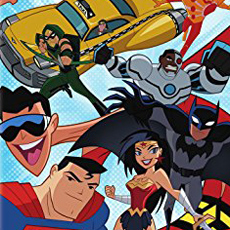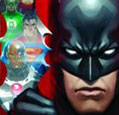Warner Bros. (2001), Warner Home Video (August 19, 2008), 3 discs, 575 mins plus supplements, 1.33:1 original full frame ratio, Dolby Digital 5.1, Not Rated, Retail: $59.98
Storyboard:
DC Comics’ greatest heroes unite to battle the forces of evil and injustice, in a series that brings the old Super Friends into the modern DC Animated universe. And now they’re in high definition!

The Sweatbox Review:
(Note: Portions of this review originally appeared in our review of the DVD version of this title.)
It was to be a dream come true for DC Comics fans. After years of producing the definitive Batman cartoon, and a pretty decent Superman show, it was rumored that Bruce Timm and his cohorts would be creating a show featuring a number of DC’s elite heroes. The rumor was denied for some time, but it was eventually announced that Cartoon Network would be showing the new Justice League series in 2001.
Following the lead of the classic Justice League Of America comic books, the series would star Superman, Batman, Wonder Woman, The Flash, Green Lantern and J’onn J’onzz, the Martian Manhunter. The producers courted controversy by also including the odd choice of Hawkgirl, who in the comics was often simply a tag-along with her mate, Hawkman. Another controversy would come in the selection of which versions of Flash and Green Lantern to choose, given that there had been two or more versions of each in the comics over the years. They settled for the modern-day Flash (Wally West), and a nearly forgotten (at the time) Green Lantern, the dark-complexioned John Stewart— the latter choice, as with Hawkgirl, influenced by a desire to give the group greater diversity.
Membership quibbles aside, the series seemed destined to succeed. The show’s creators had plenty of experience playing in the DC Comics animated universe, and many of them were themselves “comic book geeks” with a vested interest in mining the depths of the glorious DC Comics legacy. Young fans would be able to discover new heroes fighting alongside Batman and Superman, while older fans would at last be able to shake the memories of Super Friends— the last show to feature the Justice League. Super Friends may continue to strike a nostalgic chord with many who watched it in the 1970s and 1980s, but it must now be admitted that it was a truly horrible show, despite its charms. I still have a great fondness for Super Friends myself, but a new take on the Justice League was something I was dying to see.

Stylistically, the show continued the evolution of the largely Timm-designed superhero aesthetic of previous shows. People looked much like they had in the Superman series, as well as the final Batman season. Superman got a little older, and Batman got longer bat-ears, but otherwise the characters continued to have a familiar, highly stylized, angular look. What changed were the backgrounds, which became less stylized in order to help ground the show more in reality. The animation was generally very good, although with occasional lapses that are inevitable for a relatively cost-conscious television show. The show’s weakest point initially was the writing; while this would improve over time, it was a bit shaky over the course of the first season.
At long last, after initially putting out a few single-disc compilations over the years, Warner Home Video released the entire first season in one DVD set, running four discs, in March of 2006. With the dawn of the high definition age, they have now put out the first season on a set of 3 Blu-ray discs. (The episodes from the first three DVDs now appearing on just two discs, while the fourth DVD and the third Blu-ray have the same episodes.)
Disc One
Justice League starts out on a fairly positive note, beginning with an exciting 90-minute debut that establishes the origin of the team. The Secret Origins story was inspired somewhat by the inaugural tale in the contemporary JLA comic, dealing as it does with a race of white Martians trying to subjugate the Earth. It does offer new touches, though— Martian Manhunter and Wonder Woman are presented as newcomers, and the group’s Watchtower is a cross between the name of the contemporary comic’s headquarters and the location of the orbiting satellite of the 1970s and 1980s comic book stories.
Unfortunately, while the initial story is high on action, it is a bit lacking in depth in the areas of motivations and character development. For all the visual pizzazz on display, it was soon feared at the time these originally aired that the show might turn out to be simply a prettier version of Super Friends. Those fears were somewhat borne out in a few of the upcoming episodes. Despite each story being given two (or more) full episodes, it was the action scenes that benefited the most. It generally made for a fun ride, but afterwards there was often a feeling of, “but what was the point?” After all, you must care about the characters if you are to care about what happens to them. Exciting action and thrilling animation can be just fine for other superhero shows, but fans who had previously enjoyed Batman: The Animated Series had come to expect more. Still, there is plenty of promise evident even in the early going.
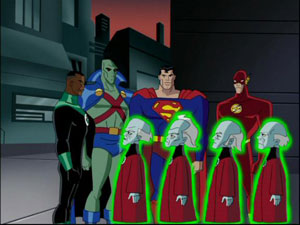
In Blackest Night continues to make cool use of DC Comics mythology, utilizing the intergalactic robotic Manhunters as adversaries. The Manhunters arrest Green Lantern, and bring him to trial out in space for destroying an entire planet. Naturally, his friends try to help him out, and there are numerous nods to various comic book stories and concepts, like the Guardians Of The Universe. There are some big action set pieces here, but there are also some plot holes that are nearly as large; still, for a show this early in the run, it is pretty neat. It certainly served notice at the time that the series was liable to take fans anywhere in the DC Universe, and bring out plenty of characters both well known and obscure.
The Enemy Below brings the action back to our own planet, as well as beneath the sea. Aquaman guest-stars, sporting his bearded, bare-chested look. He comes off as a little more like Marvel’s Sub-Mariner, though, having disagreements with the surface world over their disregard for the environment. It’s a natural take on the character, however, and is only the beginning of a plot that also brings in a threat to Aquaman’s leadership of Atlantis. The script here is a little tighter this time around, although still prone to clichéd dialog; but like the preceding story, this one shows that the writers knew how to deliver an accessible story that nevertheless could thrill comic fans.
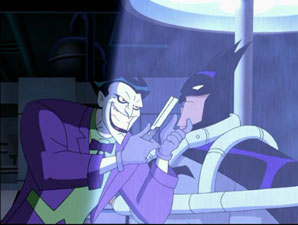
The show’s creators showed what they were really capable of in Injustice For All. Here, we catch up with Lex Luthor, who has finally been jailed now that Superman has some friends to help him. Luthor escapes jail with the apish but brainy Ultra-Humanite, and then forms a super-powered gang to take down the League. The concept for the story is enough to make it an easy classic, but it also has some truly great bits with Luthor and The Joker (with their relationship much the same as it was in the Superman: The Animated Series three-parter World’s Finest). Best of all, Batman essentially defeats the entire supervillain team despite being a prisoner for most of the story. Brilliant! This DVD set fixes the continuity problem of the original airings and the earlier single DVDs, which incorrectly placed this episode later in the season. Kudos to the producers of this set for remedying the situation.
Disc Two
Paradise Lost is a decent adventure, this time bringing old-time League foe Felix Faust into the picture. Wonder Woman discovers that Faust has turned the Amazons of her island home of Themyscira into stone. Faust forces her to work for him gathering ancient artifacts; but knowing not to trust him, Wonder Woman calls the League for help. The taint of too much action/not enough story is still apparent, and the League comes off as a little too stupid in hatching their master plan to defeat Faust, but there are plenty of nice touches once again. A new animation style is used during a history lesson (using some suspicious Greek mythology), and it is always neat seeing Wonder Woman interact with the Amazons, particularly with a certain development at the end of the story.

Paradise Lost may have been simply mediocre, but War World is truly the dog of the first season. Inspiration continues to come from the comics, with Superman being taken to War World to fight in gladiatorial games for the despot Mongul. That plot is fine, but Superman appears to have been castrated for this story. If you are going to show Superman having to be rescued by a bunch of other heroes, there had better be a load of Kryptonite around somewhere. There’s none, however, which means Superman simply has to be portrayed as being weak and wimpy. This did not sit well with me, and neither did the huge plot holes, contrived coincidences, and exceedingly poor plotting. This episode could serve as a “worst of Season One” clip show. Superman gets beat up after sand is tossed in his face, J’onn’s biggest contribution to saving Superman is having people cheer for him, and… oh, I can’t go on. It’s just too sad.
Things improve again with The Brave And The Bold, which in Part 1 pairs Flash with Green Lantern against Gorilla Grodd. It doesn’t get much more comic book-y than that, folks. The rest of the League shows up in Part 2 to help dispose of the threat that Grodd poses to the world in general and Gorilla City in particular. The first part offers some nice character interaction between two very different heroes, while the second part brings some great action for which the series was becoming known.
Fury returns us to Themyscira, as a rogue Amazon has decided to rid the world of men. Hawkgirl and Wonder Woman must deal with the threat together, and their clashing cultures bring the story many of its most memorable moments.
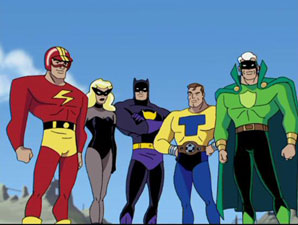
Legends is a favorite of mine. The story was originally conceived as a way of bringing in the Justice Society Of America, the World War II-era predecessors of the Justice League. Unfortunately, DC Comics scrubbed the idea, so the producers decided to proceed with their story but change the characters. The result is still an entertaining episode, with the League visiting an alternate Earth and meeting a team of simple, unbelievably earnest heroes. The Justice Society analogs are still quite plain to comic fans, and consequently this “Justice Guild” serves the story just fine, while allowing the writers greater leeway with the story elements. At times, this episode veers towards parody, but it is inspired by love for a bygone era.
Disc Three
A Knight Of Shadows brings a whole new level of “cool” to the show, depicting the Jack Kirby version of the fall of Camelot and the re-introduction of the Demon (last seen in the final season of Batman’s show). Flash-forward to the present, and we finally get a story that gives the spotlight to J’onn J’onzz. This story features some of the best characterization of the first season, exploring J’onn’s loneliness and what he would do to rid himself of it.
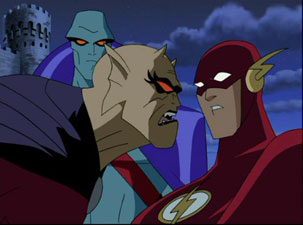
On this disc, Metamorphosis is the middle child that is lost between two more interesting siblings. Other than introducing a favorite character from comics’ Silver Age (Metamorpho), there is nothing too remarkable about this one. It almost seems like everyone was just looking forward to working on the season finale…
The Savage Time is another three-part story, nicely book-ending the first season of the show. It is also another love letter to comic book fans, taking the League back to the time of World War II to defeat Vandal Savage. Savage has brought futuristic technology to that time, enabling the Axis to win the Second World War. Time travel stories can often be very cool, but in the confines of the DC Comics Universe, the writers were also able to introduce a number of classic comics characters. Numerous non-super WWII-era characters and concepts appear, not the least of which is a very special friend for Wonder Woman. There was so much “neat-o” stuff going on in this story, it was hard to even tell if it was all that good or not. I’m kidding— I’m pretty sure it was great.
By this time, the Justice League creators had hit their stride. From here on, the series would be much more consistent and even frequently outstanding. The seeds are all here, though. You may have to get past a couple of clunkers, but viewing these episodes as a whole, one can see why the series is so well regarded. Like the characters on the show, the creators grew together as a team this season, learned from their mistakes, and would build on a number of successes on the way to becoming legends.
Well, maybe not legends exactly, but you get the idea. Justice League got even better the next couple of seasons, but there are more than enough good episodes here in Season One to make this set worth a purchase. However, if you have this set on standard DVD already, is it worth the upgrade? Read on…
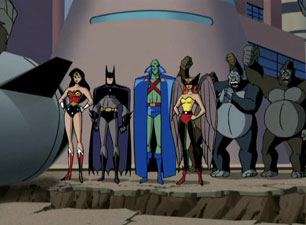
Is This Thing Loaded?
The DVD set had a nice selection of extras, among the strongest suite of extras seen on a “DC Comics Classic Collection” DVD set. They all appear on the Blu-ray, too, but still presented in just 480p. The only new extra is a Blackhawk Theme Music Video (2:40). Bruce Timm introduces this collage of scenes from The Savage Time, which runs under the music of Lolita Ritmanis. This video was originally produced for the San Diego Comic-Con, and is of little enough importance that it was dropped from the DVD set. All of the other extras here, however, are pretty cool. Other than the commentaries, all extras are on the third disc.
There are three Audio Commentaries with director Dan Riba and producers Bruce Timm, James Tucker, Rich Fogel, and Glenn Murakami. They nearly forget to discuss The Enemy Below, Part 2, as they are busy commenting on their reasoning for using two-parters, the widescreen issue and working with Cartoon Network; but eventually they do give good info on the making of this episode. They get more episode-specific for Legends, Part 2 and The Savage Time, Part 2, delivering very interesting and informative commentaries.
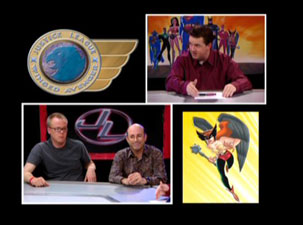
A slightly annoying Jason Hillhouse moderates a producer/director talk in Inside Justice League (9:12), which gets into the conception of the show and how everyone thought the first season went— both the good and the bad. The Look Of The League (4:18) is Bruce Timm’s discussion of the how’s and why’s of character design on the show. Storyboards for Justice (7:10) is a port from the Brave And The Bold DVD single— a chat with Dan Riba showing plenty of boards for the Injustice for All episodes.
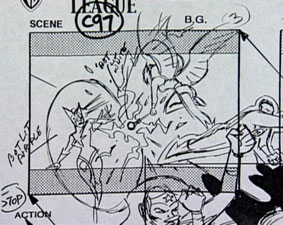
Justice League: The First Mission (5:54) is promoted on the packaging as “never before seen,” but of course it appeared on the DVD set two years ago. This featurette begins with more of Hillhouse and the producers, and ends with the 90-second promotional film they made to help sell the show. It was actually never used for that purpose, but is fascinating for allowing us now to see how they first thought they would have to conceive the show. Robin and Impulse are featured, as well as different designs for the other characters.
The Trailers from the DVD set have naturally been left off of the Blu-ray set, and have not been replaced with anything more contemporary.
Case Study:
The case used here is a slightly wider than usual Blu-ray case, with a tray in the center that holds the first and second discs on opposite sides. All of the discs are a little tricky to remove, but those experienced with such matters should be able to deal with the issue. A four-page pamphlet is inside, listing the disc contents without doing anything too special. The packaging recycles all of the DVD cover art, as well as the disc art (for the first three DVDs).
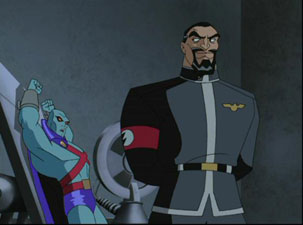
Ink And Paint:
Now here’s my only real beef with this set. With only a modest upgrade expected in the video and audio departments, I thought that Warner Home Video would at least take this opportunity to deliver fans the preferred widescreen versions of these episodes, but instead they have stubbornly stuck with the 4:3 versions. A little history:
Right from the moment this title was announced for DVD, there was some controversy as to whether the set should be brought out in a 4:3 or 1.85:1 video ratio. The producers were originally asked by Cartoon Network to make the show for 4:3 viewings, knowing that many viewers would be children accustomed to seeing their shows fill up their standard-sized TV screens. The producers argued for a widescreen presentation, and got their way… almost. The show was still produced in the 4:3 ratio, but Cartoon Network agreed to also air a widescreen version in a different time slot. As a result, the widescreen image does cut off the picture at the top and bottom; but because the show was composed with this in mind, the cropped image is actually more dynamic and aesthetically pleasing. The producers and most fans therefore tend to prefer the widescreen image.
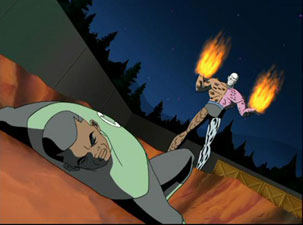
An argument could be made for either version to be used for home video, as both versions were the “intended” way for the show to be shown, depending on your point of view. In the end, Warner Home Video decided to present the entire 4:3 image for the DVD set. No image is lost in this version, and widescreen set owners could always zoom in to do their own cropping. That’s what I have always done— on my Hitachi widescreen set, zooming works almost perfectly. And I guess I shall continue to do so, as these Blu-ray discs hold the very same 4:3 images that the DVDs did. It’s not that big of a deal, really, but I do find it bizarre that Warner missed an obvious opportunity to satisfy fans with a widescreen image, tailor-made to the aspect ratio of high definition TVs. Of course, with zooming, it does make it tricky to use the pop-up menus. Okay, zooming is actually a bit of a pain. But I can deal with it, I guess. No choice, apparently.
Now, for the other big question, and you know what it is, so I’ll skip to the answer. Justice League DOES look better on Blu-ray. You don’t notice it so much with the figures, except for outlines being a tiny bit less jagged. The biggest improvement comes with the painted backgrounds and the overall vibrancy of the colors. With these pairs of screen captures, I have placed the DVD image above the Blu-ray image. I took these photos off of my high def TV using a digital camera. Keep in mind that these may not be exact frame match-ups, and one must remember that we have to compress images for posting to this site, but I think you can still make out the differences. The Blu-ray image tends to be better defined, giving the picture a “pop” that the DVD can’t quite match. The castle below clearly comes off better in high def, with the DVD picture looking far murkier, and with less color distinction besides.
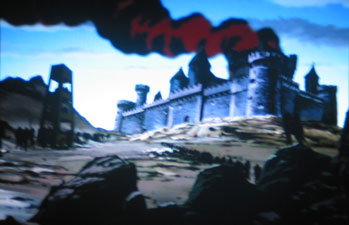

The difference is subtler in this shot of the Justice League satellite, but still the DVD picture has a slight haze that the Blu-ray picture lacks. Overall, the Blu-ray definitely has the edge.

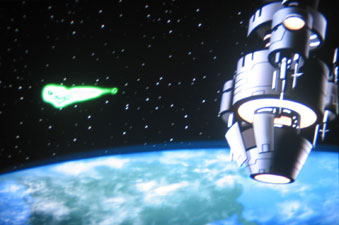
Scratch Tracks:
I was pretty impressed with the Dolby Surround Stereo audio on the Justice League: Season One DVD, only lamenting the lack of a 5.1 remix. That has been rectified for the Blu-ray, with the long-awaited 5.1 mix appearing here. Unfortunately, it’s not using a high def audio codec, and the 5.1 mix is really not all that much better than the 2.0 one, but for a TV show there is still pretty decent bass and surround effects, only mostly confined to the front speakers.
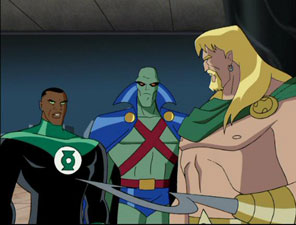
Just as with the DVD, only an English soundtrack is provided. However, the Blu-ray adds English subtitles for the hearing impaired, but takes away the options for French or Spanish subtitles that had appeared on the DVD.
Final Cut:
This was a flawed first season for Justice League, but it’s both better than people gave it credit for at the time, and not as great as it would become in the next few seasons— particularly after it became Justice League Unlimited. With a list price of $15 more than the DVD set, it is hard to state definitely that a Blu-ray purchase is worth the upgrade, but the Blu-ray is undoubtedly the better product for those with Blu-ray players. The video is superior, though really only noticeable with a direct comparison, and more obvious with still shots than while the show is running. The audio quality is a bit of a wash, and the extras are the same except for the addition on the Blu-ray set of a basically useless music video. I’m going to grade the Blu-ray set the same as I did the DVD set, but realize that the scales are different, particularly when it comes the video, which ends up being the real reason here to consider going Blu.
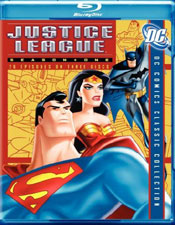 | ||
 |








